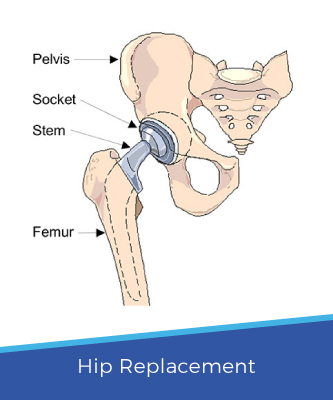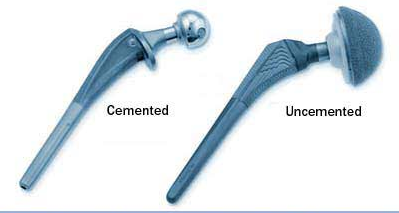Hip replacement surgery procedure is one of the most popular and effective treatment method for correcting damage to the hip joint as well as treating other painful symptoms in order to restore movement in the hip joint.
There are mainly two main methods of hip replacement surgery procedures, these are:
Total Hip Replacement
In this surgical procedure, the surgeon will be required to remove small portion from the top of the thigh bone (femoral head). The surgeon will then replace the femoral head (ball portion of the hip joint) with an artificial device which mimics the characteristics of the natural femoral head.

The surgeon will also need to roughen the socket part (acetabulum) of the hip joint to fix an artificial implant in place. This new acetabula implant fits snugly in the artificial femoral head implant device.
Mostly, the surgeon will attach the artificial implants using acrylic cement, however, in younger patients the surgeon will insert one of the parts (socket of the femoral head) using no cement and with external fixation device such as small metal screws, plates, etc. The bone surface is rubbed to make it rough in texture. This helps the bone to grow back and include the artificial implants in them eventually.
Hip Resurfacing Procedure
This is another popular form of hip replacement procedures. Hip resurfacing procedure requires the surgeon to rough up the surface of the socket in the acetabulum and the ball-end of the femur (thigh bone). This allows the surgeon to simply cap the femoral head and the acetabular socket with metal implants instead of removing a portion of the hip joint bones and replacing them completely.
This is advantageous as it has a lower risk of being dislocated and provides higher level of sports and physical activity as compared to the conventional total hip replacement procedure.
Types of Hip Implants
The artificial implant components used to replace or resurface the damaged hip joint are made from a wide range of materials, such as:
Metal-on-Metal – In Metal-on-Metal hip implant, the artificial hip joint components are made from medical-grade metal. However, these tend to get worn out faster in comparison as the friction between metal and metal is damaging to the implant. Apart from this, there is also the risk of metal ions being released by the friction between the metal hip joint components, which leads to a medical condition known as ‘metallosis’.

Ceramic-on-Metal – In this type of hip implant the components include a femoral head ball made from ceramic which fits neatly into a metal-lined acetabulum. There is comparatively less friction between metal and ceramic as compared to metal and metal. This proves to make these types of implant material more advantageous.
Ceramic-on-Ceramic – This hip implant includes the ball component and the socket portion made from medical-grade ceramic. These are found to be even more advantageous as compared to ceramic and metal components as the smooth ceramic components tend to create far less amount of friction. It makes these implant more durable as well as stronger.
Plastic – These are more advanced and are used to line the acetabular socket with metal and replacing the femoral head with a ceramic ball component. The more popular types of plastic hip replacement implant types are ceramic-on-polyethylene and metal-on-polyethylene. Highest quality of plastic is used in making these polyethylene implants as these are tough and hard to get worn out.
The Hip replacement surgery cost in India is the lowest when compared to other similar countries, adding on to it is the fact that India has some of the finest and high-class healthcare facilities which specialize in joint treatment.
